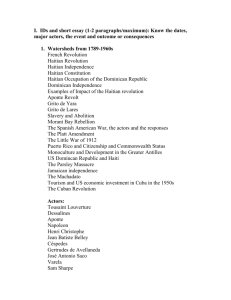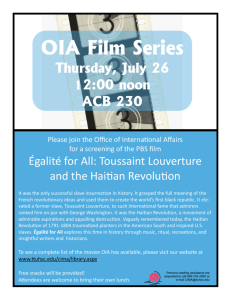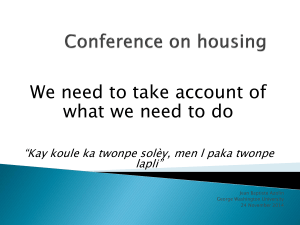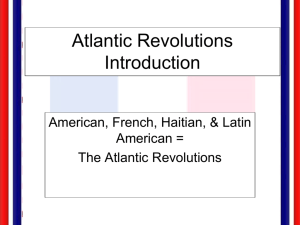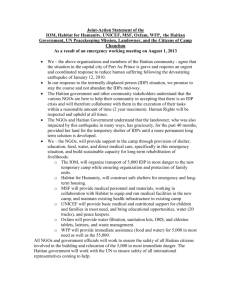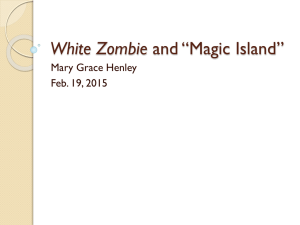Effective Communication with Immigrant Population
advertisement
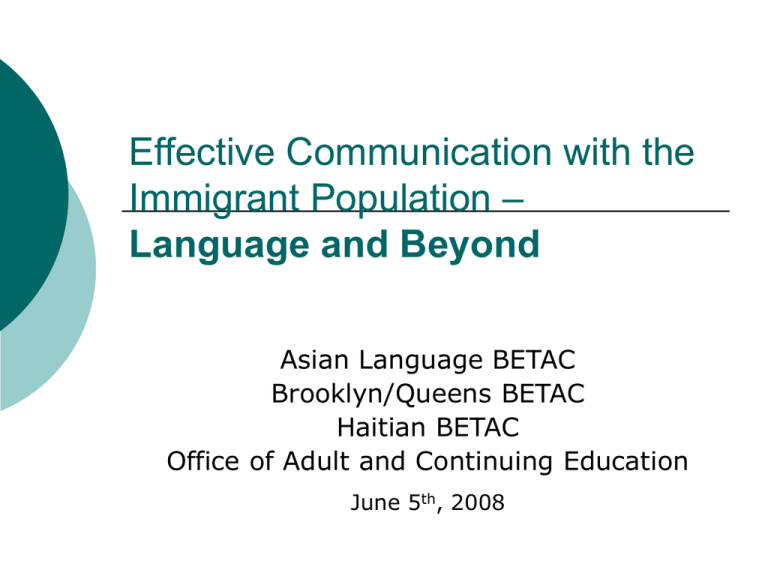
Effective Communication with the Immigrant Population – Language and Beyond Asian Language BETAC Brooklyn/Queens BETAC Haitian BETAC Office of Adult and Continuing Education June 5th, 2008 Workshop Agenda Overview of New York State Bilingual ESL Technical Assistance Center (BETACs) Overview of the need of effective communication with immigrant population Language and culture awareness panel presentation Haitian West African East Asian South Asian Spanish Q&A Mission Statement of the New York State BETACs To enhance the development of knowledge and competencies of educators, parents and local communities needed to support academic excellence of limited English proficient / English language learners (LEP/ELLs) in New York State. 3 Where the BETACs are… 4 Statewide Language BETACs ALBETAC (Asian Languages) HABETAC (Haitian Language) SBETAC (Spanish Language) ALBETAC Provide technical assistance to schools and school districts with ELLs from Asian language backgrounds and Students enrolling in Asian languages programs Focus on 6 top Asian language groups: (Arabic, Bengali, Chinese, Korean, Urdu and Russian) HABETAC Resource Center Haitian Spelling Bee Essay and Art Contest Career Day for Haitian High School Students Haitian Studies Association Haitian Media and CBO Collaborations Annual Conference on the Education of the Haitian Child Haitian materials development and translation support SPANISH BETAC Spanish Spelling Bee Annual Children’s and Young Adults’ Literature Symposium Spanish Language Literature Institute Plazas Comunitarias Network Collaborations with teacher preparation programs Language resources and translation support Most Spoken Languages in New York State in 2000 • English is spoken by 72.04 % of people over 5 years of age in New York state. • Languages other than English are spoken by 27.95%. • Speakers of other languages are divided up as follows: Source: Census 2000, Summary File 3, STP 258 LEP/ELLs in New York State NYS LEP/ELLs Served: 198,425* Language Percentage Spanish Chinese Haitian Creole Russian Korean Other Languages (167) 68% 7% 4% 4% 2% 15% 10 Major Language Groups in NYC Schools Source: BESIS, 2006-07 Total ELL Population: 139,842 ARABIC 2% Others 7% BENGALI 3% CHINESE 11% KOREAN 1% PUNJABI 1% RUSSIAN 2% URDU 2% Haitian 2% ARABIC BENGALI CHINESE KOREAN PUNJABI RUSSIAN URDU French 1% Haitian French Spanish Spanish 68% Others What we learned from your responses Program participants reflect the linguistic diversity of New York State. Key areas of concerns identified in the survey include: inconsistent participation, information on public services and communitybased organizations (jobs, immigration, housing, etc.), multilingual on-line resources, instruction strategies (special ed, ESL, literacy) participants lacking literacy skills in their native languages, education systems in other countries, and effective communication with people from different cultures. Do you know what language this is? There are 10 cards in white indicating 10 different languages. . There are 10 cards in green providing a phrase in the 10 languages. Your assignment Match the sentence to its corresponding language. Do you know what language this is? ARABIC 老師歡迎學生 CHINESE POLISH KOREAN URDU BENGALI Pwofesè a HAITIAN salye elèv yo. El maestro Saluda a SPANISH los estudiantes RUSSIAN Panel Presentation – Languages and Cultures Moderator – Silvestre Wallace, Associate, NYS Office of Bilingual Education) Haitian (Lily Cerat, HABETAC) West African (Virginia Jama, B-Q BETAC) East Asian (Pat Lo, ALBETAC) South Asian (Tamo Chattopadhay, ALBETAC) Spanish (Nancy Fernandez, OACE) Making Cross-Cultural Connections: Understanding the Haitian Immigrant Adult Learner NYS HABETAC @ Brooklyn College June 5, 2008 Brooklyn Adult Learning Center Haïti An Overview History Geography The Haitian People Who are we? • Native Taïno (Arawak) • African (Mainly from the Kingdom of Dahomey – West Africa) • European (colonists: Remnants of Spaniard, English, French, Polish*, etc.) • Economically poor, but culturally rich The Languages of Haïti • Haiti has two official languages: French and Haitian Creole • Haitian Creole is spoken by everybody • French is spoken by individuals who have had some schooling • And more… Religious Practices in Haïti Christianity: Catholicism Protestantism Vodoo: is a word from the Dahomean language of West Africa that means spirit, god, or the “sacred” Others: (Jewish, Hindu, Mormon, Muslim, etc.) Holidays in Haïti • • • • • • • • • Historical Dates January 1 ( Independence Day & New Year) May 18 (Haitian Flag Day) November 18 (Batailles de Vertieres) Cultural Dates November 1 and 2 (All Saints’ Day) December – Christmas February ( Carnival) April ( Lent – Rara) Women in Haitian Society • Patriarchal society (male dominated) • Women in Haiti are the backbone of the economy (ti machann) -- Of the 40% of employed the majority is women • Haiti is one country where there is a Ministry on the Conditions of Women. It was created under Aristide • Women/girls and Educational Opportunity Adaptation to Life in the U.S. • • • • • • • Haitian Immigration into the US 1600 – 1803: St. Domingue & Louisiana 1772: Jean Baptiste Point du Sable 1779: 800 Haitian soldiers fought w/American revolutionaries @ Savannah, Georgia 1787: Pierre Toussaint (Philanthropist) Census Records Register 1820 - 1930 = (20 Haitians each); 1961–1970 = 34,499; 1981-1990 = 138,379 Today there are 500,000 Haitians in New York (documented and undocumented) Health Care, Teaching, Human Services, Factory & Maintenance work Resources to help • Haitian Historical & Cultural Legacy: A Teachers’ Resource Guide • Bilingual English-Haitian Creole Glossaries • Haitian Creole Library Lists West African Cultural Notes Looking at our adult students from West Africa in New York City Virginia Jama Brooklyn Queens Regional BETAC Long Island University West Africa, continued • There are over 20 countries in West Africa. We are talking about subSaharan places. • Personal notes—history—teaching English in northern Nigeria. • Also taught in Somalia for four years. General Information • Colonial history—countries were carved out of vast areas without regard to cultural groups or languages. • Some languages spoken in West Africa: Mandingo, Wolof, Bambara, Hausa (lingua franca), Yoruba, Ibo. • French, English, Arabic, Portuguese. • Religious differences Education and Adjustment • Degrees of literacy • Nomadic pastoralists versus agricultural settled people. City-dwellers. • Cultural adjustment here in the U.S.: need English, need literacy. Constant worry about how the family is doing “back home.” Political concerns. Gender Issues • • • • Women’s special cases Been thru hardships. Civil wars in Sierra Leone, Liberia Married men travel a lot. Women left for months with kids, relatives. Waiting for money. Absent from your programs. Or Late. Considerations • Teenage girls are forced to work in braiding salons. • No time off on weekends to study • Staying with family members or not so close relatives Education systems • More documentation is required now re. graduation from schools in West Africa. • However, it is hard to produce it. • Considerations for classroom behaviors: students don’t look you in eye. • Students help each other. Whisper—allow for this. Don’t have supplies. • Different literacy experiences. Allow for that. End Piece • Congratulations on the work you do. • People are finally getting the opportunity to continue their education. Even begin their education…because of your programs. CULTURAL NOTES ON EAST ASIA Presented by Pat Lo, Director ALBETAC Legend Asian Languages Chinese Korean Arabic Russian Bengali Urdu Japan Burmese Tibetan Vietnamese Punjabi Hindi ■ ■ ■ ■ ■ ■ Some commonalities Respect education. Family comes before selves. Celebrate the Lunar New Year. Japanese and Korean also use Chinese characters. Chinese, Vietnamese, and Thai are all tonal languages. General Information Languages Where it’s spoken Chinese (Mandarin and local dialects) Hong Kong, People’s Republic of China, Taiwan Korean Republic of Korea Ethnic Groups Han People (91.5%) with 55 minority groups including Korean, Tibetan, and Mongolian Korean and small Chinese minority Religion(s) Confucianism, Taoism, Buddhism, Christianity, Islam Confucianism, Christianity, Buddhism, Education Nine years compulsory education Nine years compulsory education Family name first Family name first Name Gender Issues Then: Men were head of household Women were subservient to husbands Women’s main role was to produce an heir/care for home and family Now: Shared household responsibilities Women now work outside of the home Married women keep their maiden names China’s one-child policy Educational Considerations Class size Teaching approaches School expectations for students Parent involvement Discipline Special needs Chinatown Flushing Brooklyn Manhattan Korea Town Manhattan Flushing, Queens The Chinese and Korean Communities Celebrate the Lunar New Year in Flushing, Queens On-line Resources ALBETAC http://steinhardt.nyu.edu/metrocenter/A LBETAC.html Directory of Asian community Based Organizations http://steinhardt.nyu.edu/metrocenter/ALBE TAC/Resources/newenglishversion.pdf Translated Glossaries http://steinhardt.nyu.edu/metrocenter/ALBE TAC/Resources/translatedglossaries.html Encountering the South Asian Community Dr. Tamo Chattopadhay ALBETAC Consultant Adjunct Assistant Professor at School of International and Public Affairs Columbia University in New York 43 Where in the World? East Asia, South Asia, and South East Asia Shared Historical and Cultural Legacy • Colonial India – today’s India, Pakistan and Bangladesh • Gandhi and the independence movement • The religion issue: Hindus and Muslims • Division of the territory – birth of India and Pakistan in 1947; Birth of Bangladesh 1971 • The word Bangladesh means literally the country (desh) of the Bengali language (Bangla) Major South Asian Languages in NYC Schools • • • • • • Bengali (2.7%) Urdu (1.9%) Punjabi (0.7%) Hindi (0.2%) Pashto (0.2%) Gujarati (0.1%) Bengali Language – Where Is It Spoken? West Bengal, India Bangladesh Bangladesh Official name: People's Republic of Bangladesh National flag: Capital: Dhaka Independence day: 26 march, 1971 Currency: Taka (BDT) Bangladesh is a country bordering The bay of Bengal, between Myanmar And India, and size-wise it is slightly Smaller than Iowa Bangladesh – Quick Facts Based Upon CIA Factbook https://www.cia.gov/library/publications/the-worldfactbook/geos/bg.html • Population: 150 million (2007); Urban Population: 26% • Population below Poverty Line: 45% (2004 • Adult Literacy: Males:54% Females: 32% • Most of Bangladesh is situated on deltas of large rivers and is prone to severe floods in monsoons Education System in Bangladesh • The education system is divided into 4 levels-primary (from grades 1 to 5), secondary (from grades 6 to 10), higher secondary (from grades 11 to 12) and tertiary • Alongside national educating system in Bengali, English medium education is also provided by some private enterprises. They offer 'A' level and 'O' level courses • There are non-governmental schools (NGO) and non-formal education centers (NFE) run by NGO-s; Many of these are funded by the government. The largest NFE program is the much reputed BRAC program. These programs cater to the socioeconomically disadvantaged population not served by the government schools. But rarely they extend beyond the primary level • There is also a Madrasa system which emphasizes on Arabic medium Islam-based education Perspectives on Bangladeshi Immigrants Some (Gross) Generalizations • Respect for ‘authority’ of the school administration and teachers • The stigma of “special education” • Extended family support systems • Gendered division of labor • Gender dynamics in communication (health) • Issues with names and registration documents Did You Know? • • • • 21st February – UN international mother language day Bengali becomes official language of sierra Leone 2002 1913 first Nobel prize from Asia to Bengali poet Rabindranath Tagore 2007 Nobel peace prize to dr. Mohammed Yunus Useful Resources to Refer To: • Consulate General of India in New York http://www.indiacgny.org/ • Consulate General of Bangladesh in New York http://www.bdcgny.org/ • Asia Society: http://www.asiasociety.org/ • Southern Asian Institute at Columbia University http://www.sipa.columbia.edu/REGIONAL/SAI/ind ex.html • South Asian Youth Action http://www.saya.org/ • Online Bengali Dictionaries http://www.virtualbangladesh.com/dictionary.html http://dsal.uchicago.edu/dictionaries/biswasbengali/ This Is No Flood, Just a Bit of Rain And There Is Always Time to Play.. THANK YOU! Spanish Speaking Groups & Latin American Cultures Nancy Fernandez Assistant Principal Office of Adult and Continuing Education Residential Patterns of NYC’s Latinos Puerto Ricans: Nearly two thirds live in the Bronx and Brooklyn and then Manhattan and Queens Mexicans: High concentration in Queens then Brooklyn and the Bronx Ecuadorians: heavily concentrated in Queens Colombians: concentrated in Queens Percentages of Largest Latino Groups Living in Each Borough Bronx- 39.1% Manhattan-15.7% Staten Island 4.4% Brooklyn- 26.8% Queens- 14.0% Gender Differences Culturally assigned roles to men and women e.g. Men work and women stay home with the children; men may arrive late at home, but woman must stay home. More women in ESL classes than men during the day- because women are home with the children. Decisions are generally made by the man If women work, often they are expected to bring home the money. POVERTY LEVELS Of 100% immigrants at poverty level, the breakdown is as follows: Mexicans- 33% Other Hispanics/ Latinos- 30% All other ethnic groups- 37% Linguistic Needs One Hispanic Language- different vocabulary based on cultural diversity ex: dialects within the home country of the immigrant- Indigenous language in Mexico, Peru Varying dialects, e.g. tunica o vestido same meaning different vocabulary Regionalism- change the ending of some of the vowels and consonants- ex. comer, comi, comel Educational Attainment Of the total Latino population in NYC.. Almost 15% of Central and South Americans have less than a 6th grade education Almost 29% of Mexicans- less than 6th grade Almost 18% of Dominicans- less than 6th grade Almost 12% of Puerto Ricans- less than 6th grade Almost 8% of other Hispanic groups- less than 6th grade Trivia 2008 Olympics will be held in this city… These languages can be written from the right to the left… This country shares an island with the Dominican Republic… The largest immigrant group in the US comes from this country… This country was the former East Pakistan… This country is the most populous Muslimmajority nation… Your Turn Comments Questions? 謝 謝

